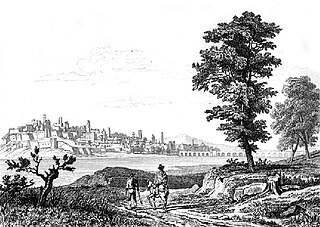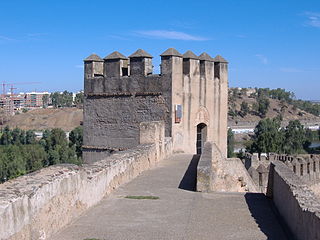
The Peninsular War (1807–1814) was the military conflict fought by Spain, the United Kingdom and Portugal against the invading and occupying forces of France for control of the Iberian Peninsula during the Napoleonic Wars. In Spain, it is considered to overlap with the Spanish War of Independence. The war began when the French and Spanish armies invaded and occupied Portugal in 1807 by transiting through Spain, and it escalated in 1808 after Napoleonic France had occupied Spain, which had been its ally. Napoleon Bonaparte forced the abdications of Ferdinand VII and his father Charles IV and then installed his brother Joseph Bonaparte on the Spanish throne and promulgated the Bayonne Constitution. Most Spaniards rejected French rule and fought a bloody war to oust them. The war on the peninsula lasted until the Sixth Coalition defeated Napoleon in 1814, and it is regarded as one of the first wars of national liberation and is significant for the emergence of large-scale guerrilla warfare.

The War of the Oranges was a brief conflict in 1801 in which Spanish forces, instigated by the government of France, and ultimately supported by the French military, invaded Portugal. It was a precursor to the Peninsular Wars, resulting in the Treaty of Badajoz, the loss of Portuguese territory, in particular Olivenza, as well as ultimately setting the stage for the complete invasion of the Iberian Peninsula by French forces.

The Battle of Albuera was a battle during the Peninsular War. A mixed British, Spanish and Portuguese corps engaged elements of the French Armée du Midi at the small Spanish village of Albuera, about 20 kilometres (12 mi) south of the frontier fortress-town of Badajoz, Spain.

The Battle of Corunna, in Spain known as Battle of Elviña, took place on 16 January 1809, when a French corps under Marshal of the Empire Jean de Dieu Soult attacked a British army under Lieutenant-General Sir John Moore. The battle took place amidst the Peninsular War, which was a part of the wider Napoleonic Wars. It was a result of a French campaign, led by Napoleon, which had defeated the Spanish armies and caused the British army to withdraw to the coast following an unsuccessful attempt by Moore to attack Soult's corps and divert the French army.

The Battle of Barrosa was part of an unsuccessful manoeuvre by an Anglo-Iberian force to break the French siege of Cádiz during the Peninsular War. During the battle, a single British division defeated two French divisions and captured a regimental eagle.

Don Pedro Caro y Sureda, 3rd Marquis of la Romana was a Spanish general of the Peninsular War.

The Battle of the Gebora was a battle of the Peninsular War between Spanish and French armies. It took place on 19 February 1811, northwest of Badajoz, Spain, where an outnumbered French force routed and nearly destroyed the Spanish Army of Extremadura.

At the siege of Burgos, from 19 September to 21 October 1812, the Anglo-Portuguese Army led by General Arthur Wellesley, Marquess of Wellington tried to capture the castle of Burgos from its French garrison under the command of General of Brigade Jean-Louis Dubreton. The French repulsed every attempt to seize the fortress, resulting in Wellington's withdrawal. The siege took place during the Peninsular War, part of the Napoleonic Wars. Burgos is located about 210 kilometres (130 mi) north of Madrid.

In the Battle of Maguilla a British cavalry brigade led by Major General John Slade attacked a similar-sized French cavalry brigade commanded by General of Brigade Charles Lallemand. The British dragoons scored an initial success, routing the French dragoons and capturing a number of them. The British troopers recklessly galloped after their foes, losing all order. At length, the French reserve squadron charged into the British, followed by the French main body which rallied. With the tables turned, the French dragoons chased the British until the horses of both sides were too exhausted for the battle to continue. The action took place during the Peninsular War, near Maguilla, Spain, a distance of 17 kilometres (11 mi) northeast of Llerena.

Armand Philippon, sometimes called Phillipon, was a French soldier during the French Revolution and the subsequent First French Empire.

The Battle of Bayonne saw the French garrison of Bayonne led by General of Division Pierre Thouvenot launch a sortie against a besieging force of British, Portuguese, and Spanish troops commanded by Lieutenant General John Hope. The fighting marked the last major battle of the Peninsular War and occurred after unofficial news of Napoleon's 4 April abdication reached the opposing forces. Thouvenot's reasons for initiating the sortie are not clear because there was apparently nothing for the French to gain by fighting. After the French enjoyed initial success, Allied forces drove them back inside Bayonne. The French suffered 910 casualties while the Allies lost 838 killed, wounded, and captured.

In the Battle of Campo Maior, or Campo Mayor, on 25 March 1811, Brigadier General Robert Ballard Long with a force of Anglo-Portuguese cavalry, the advance-guard of the army commanded by William Beresford, clashed with a French force commanded by General of Division Marie Victor de Fay, marquis de Latour-Maubourg. Initially successful, some of the Allied horsemen indulged in a reckless pursuit of the French. An erroneous report was given that they had been captured wholesale. In consequence, Beresford halted his forces and the French were able to escape and recover a convoy of artillery pieces.

The first siege of Badajoz was a siege carried out during the Peninsular War on the Spanish town of Badajoz, by the French general Soult.

The fourth siege of Badajoz took place from July to October 1658 during the Portuguese Restoration War. It was an attempt by a huge Portuguese army under the command of Joanne Mendes de Vasconcelos, governor of Alentejo, to capture the Spanish city of Badajoz, which was the headquarters of the Spanish Army of Extremadura. The fortifications of Badajoz were essentially medieval and considered vulnerable by the Portuguese, and had already been attacked by them three times during this war.

The Battle of Saguntum saw the Imperial French Army of Aragon under Marshal Louis Gabriel Suchet fighting a Spanish army led by Captain General Joaquín Blake. The Spanish attempt to raise the siege of the Sagunto Castle failed when the French, Italians, and Poles drove their troops off the battlefield in rout. The action took place during the Peninsular War, part of the Napoleonic Wars. Sagunto lies a short distance from the east coast of Spain, about 30 kilometres (19 mi) north of Valencia.

In the Siege of Pamplona a Spanish force led by Captain General Henry O'Donnell and later Major General Carlos de España blockaded an Imperial French garrison under the command of General of Brigade Louis Pierre Jean Cassan. At first, troops under Arthur Wellesley, Marquess Wellington surrounded the city, but they were soon replaced by Spanish units. In late July 1813, Marshal Nicolas Soult attempted to relieve the city but his operation failed in the Battle of the Pyrenees. Cassan capitulated to the Spanish after the French troops in the city were reduced to starvation. The surrender negotiations were marred by French bluffs to blow up the fortifications and Spanish threats to massacre the garrison, neither of which occurred. Pamplona is located on the Arga River in the province of Navarre in northern Spain. The siege occurred during the Peninsular War, part of the Napoleonic Wars.

In the Battle of Zújar of the Peninsular War, part of the Napoleonic Wars, on 9 August 1811 an Imperial French division from Nicolas Soult's army attacked a Spanish division belonging to Manuel Alberto Freire de Andrade y Armijo's Army of Murcia. The French division, led by Nicolas Godinot, defeated Joseph O'Donnell's Spanish division with heavy losses. Zújar is located on Route 323, 13 kilometres (8 mi) northwest of Baza, Granada in Spain.

The Siege of Figueras, which lasted from 10 April to 19 August 1811, saw the Spanish garrison of Sant Ferran Castle led by Brigadier General Juan Antonio Martínez defend against an Imperial French force commanded by Marshal Jacques MacDonald and his deputy Louis Baraguey d'Hilliers. Martínez and his men held out much longer than expected but were eventually starved into surrendering the fortress, which was near Figueres. The action occurred during the Peninsular War, part of the Napoleonic Wars.

The second siege of Badajoz saw an Anglo-Portuguese Army, first led by William Carr Beresford and later commanded by Arthur Wellesley, the Viscount Wellington, besiege a French garrison under Armand Philippon at Badajoz, Spain. After failing to force a surrender, Wellington withdrew his army when the French mounted a successful relief effort by combining the armies of Marshals Nicolas Soult and Auguste Marmont. The action was fought during the Peninsular War, part of the Napoleonic Wars. Badajoz is located 6 kilometres (4 mi) from the Portuguese border on the Guadiana River in western Spain.

The Battle of Arzobispo on 8 August 1809 saw two Imperial French corps commanded by Marshal Jean-de-Dieu Soult launch an assault crossing of the Tagus River against a Spanish force under José María de la Cueva, 14th Duke of Alburquerque. Alburquerque's troops rapidly retreated after suffering disproportionate losses, including 30 artillery pieces. El Puente del Arzobispo is located 36 kilometres (22 mi) southwest of Talavera de la Reina, Spain. The action occurred during the Peninsular War, part of a larger conflict known as the Napoleonic Wars.